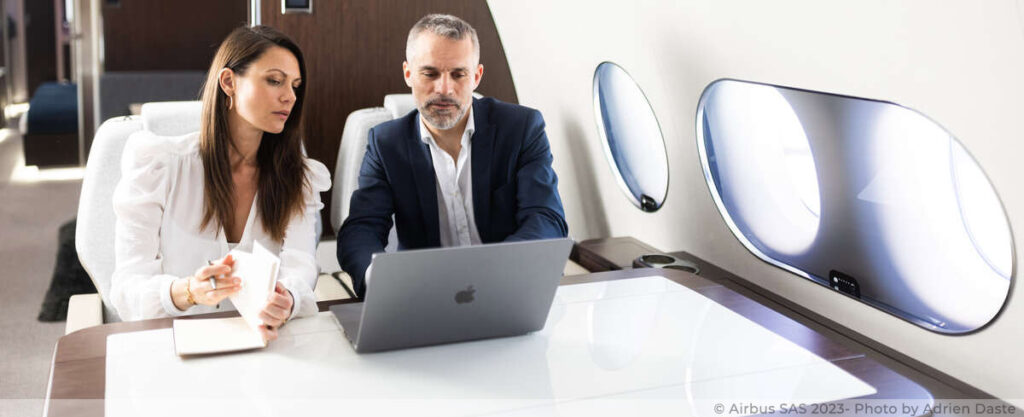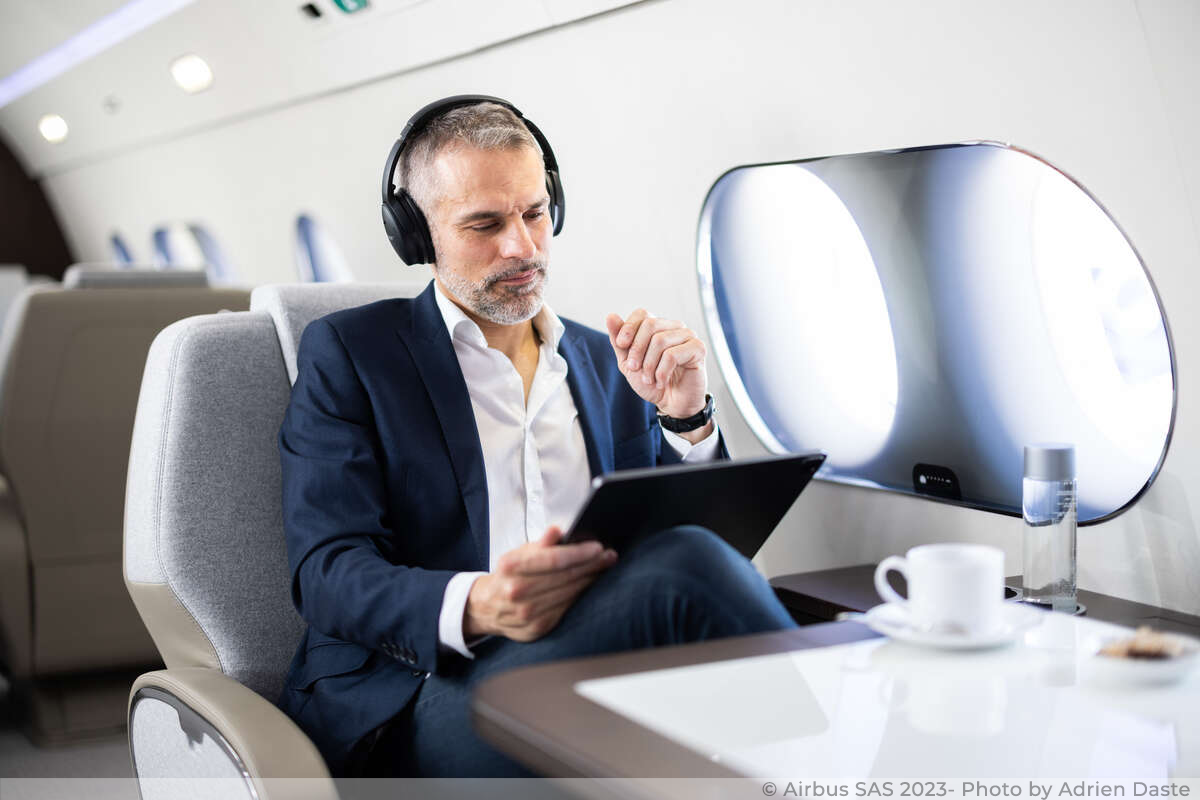In 1929, a man named Harry Ogg took to the skies with a folding desk, a typewriter, and a secretary named Katherine. His custom-built Travel Air 6000 monoplane wasn’t a novelty, it was the world’s first flying office. While most people were still waiting to install indoor plumbing, Harry had a fully functioning work setup with custom office furniture, soundproofing, and an Ediphone for dictation at 5,000 feet – luxuries unheard of in the air at the time.
This pioneering setup, which Camber previously explored back in 2020, was truly ahead of its time.
Today, Mr Ogg might raise an eyebrow at the idea of running a board meeting from an aircraft cabin somewhere over the South Pacific, but he’d understand the impulse. The sky, it turns out, is a very productive place to be. And business aviation can now finally deliver on a promise it’s been making for nearly a century: to turn travel time into productive working time.
Business Before Beverage Service
If you rewind to even just fifteen years ago, inflight productivity was… aspirational. You could answer a few emails if the connection held, maybe fire off a text at cruising altitude if you were lucky. Watching a film was less about entertainment and more about distraction because real work – the kind that requires files, calls, live updates, or a secure VPN – was firmly grounded.
Then came the satellites. And the bandwidth. And the shift we’d been waiting for.

Connectivity: From Patchy Luxury to Essential Infrastructure
The new generation of inflight systems doesn’t just offer email: it offers office-grade bandwidth. Systems like Starlink, Gogo Galileo, and Viasat’s Jet ConneX now deliver speeds that rival your office Wi-Fi, and in some cases beat it. Download speeds north of 200 Mbps with latency low enough for Zoom calls. All with full gate-to-gate coverage – not only the mid-flight sweet spot.
And it’s all accessible from your own device, using your own apps, over a secure digital connection.
Camber Aviation Management CEO Tom Chatfield has watched this change take place from up close. “It used to easily cost $100,000 a month to operate a high-speed system on a large jet,” he recalls. “Now we’re seeing systems installed for less than the previous monthly figure – with better performance and a fraction of the ongoing cost.”
Camber recently oversaw one such installation on a Global 6000. The installation came in at around $530,000, with ongoing service costing at less than $25,000 per month. “That’s no longer just a luxury,” says Tom. “That’s a viable business tool.”
The Rise of the Flying Workspace
With systems like these, aircraft cabins are no longer passive spaces between meetings – they are the meetings. The cabin is now part of the workday, not an interruption to it. You can run live strategy sessions, pitch to investors, update cloud dashboards, or present to the board from 40,000 feet, without touching a cabin handset. And clients increasingly expect this kind of continuity. “It’s not about being entertained any more,” says Tom. “It’s about staying operational. Executives want to lead from the sky without missing a beat.”
That expectation is changing the way we use jets – and how they’re designed.
Designing for the Work-Anywhere Era
In the last few years, there’s been a quiet shift from simply creating beautiful interiors to creating functional ones. That might mean setting up a quiet workspace with adjustable lighting and built-in screens, designing a secure connectivity suite into a boardroom-style table, or planning a full tech refresh during a cabin refurbishment. “Every aircraft is different. Every client is different,” Tom explains. “But the common denominator is that people want the same quality of interaction and decision-making in the air as they’d have on the ground.” Camber’s partnerships with design and visualisation specialists such as KipCreating and SkyStyle make it possible to preview how that environment will feel, function and flow – long before work begins.
A New Kind of Working, A New Kind of Cabin
But the shift isn’t confined to the technical – it’s cultural as well. For many of today’s clients (especially digital-native entrepreneurs and next-gen executives) constant connectivity isn’t a novelty, it’s a baseline. Many built their businesses in group chats and virtual boardrooms, where decisions are made on the fly – sometimes literally.
“There’s a generational shift happening,” says Tom. “It’s no longer about trying to replicate your ground office, it’s about freeing yourself from it.”
That shift in mindset is starting to shape how cabins are designed. Instead of traditional entertainment systems, clients are asking for screen mirroring that works seamlessly and securely across all devices. Soundproofed zones and adaptive lighting schemes are becoming standard. And the cabin itself is evolving into a collaborative space that’s less like a lounge and more like a studio at 40,000 feet.
Choosing When to Connect. And When to Switch Off
Interestingly, as connectivity improves, so does the ability to step back from it. The new luxury isn’t solely about working from the sky – it’s choosing when not to. “With reliable systems in place, the pressure to ‘catch up’ later disappears,” Tom explains. “That gives people room to slow down, think, rest or even sleep. The work is still there when they’re ready for it.” In that sense, the cabin may still encompass a mobile office, but it provides far more than that. It becomes a space to think strategically, recharge, or engage with intent, rather than just obligation.
From Mr Ogg’s Ediphone to Today’s Office Suite
If you could somehow bring Harry Ogg into the modern cabin, he’d probably smile at the idea of taking calls mid-air. He’d recognise the folding table. He’d likely nod in approval at the galley. But what would really surprise him is what’s missing: the cables, the clunky equipment – the bulk of business. Today, your office doesn’t require installation. It travels with you in your pocket, in your laptop and in the seamless stream of data surrounding you. The aircraft simply supports it discreetly and elegantly.
What’s Next?
As LEO satellite constellations expand – and providers like Gogo, Inmarsat, and Starlink race to raise the bar further – the next chapter of airborne workspaces is already underway. Expect intelligent cabin layouts, predictive signal switching, integrated cybersecurity and even biometric access. But more importantly, expect a shift in mindset. For the new generation of VVIPs and global business leaders, working from the sky won’t be impressive – it will be expected.
And Camber will be there to meet that standard with cutting-edge technology but – more importantly – with the thoughtful integration, comfort and design that make those tools effortless to use.
Because even when the tech is seamless, the human experience still matters.

Choosing When to Connect. And When to Switch Off
Interestingly, as connectivity improves, so does the ability to step back from it. The new luxury isn’t solely about working from the sky – it’s choosing when not to. “With reliable systems in place, the pressure to ‘catch up’ later disappears,” Tom explains. “That gives people room to slow down, think, rest or even sleep. The work is still there when they’re ready for it.” In that sense, the cabin may still encompass a mobile office, but it provides far more than that. It becomes a space to think strategically, recharge, or engage with intent, rather than just obligation.
From Mr Ogg’s Ediphone to Today’s Office Suite
If you could somehow bring Harry Ogg into the modern cabin, he’d probably smile at the idea of taking calls mid-air. He’d recognise the folding table. He’d likely nod in approval at the galley. But what would really surprise him is what’s missing: the cables, the clunky equipment – the bulk of business. Today, your office doesn’t require installation. It travels with you in your pocket, in your laptop and in the seamless stream of data surrounding you. The aircraft simply supports it discreetly and elegantly.
What’s Next?
As LEO satellite constellations expand – and providers like Gogo, Inmarsat, and Starlink race to raise the bar further – the next chapter of airborne workspaces is already underway. Expect intelligent cabin layouts, predictive signal switching, integrated cybersecurity and even biometric access. But more importantly, expect a shift in mindset. For the new generation of VVIPs and global business leaders, working from the sky won’t be impressive – it will be expected.
And Camber will be there to meet that standard with cutting-edge technology but – more importantly – with the thoughtful integration, comfort and design that make those tools effortless to use.
Because even when the tech is seamless, the human experience still matters.

